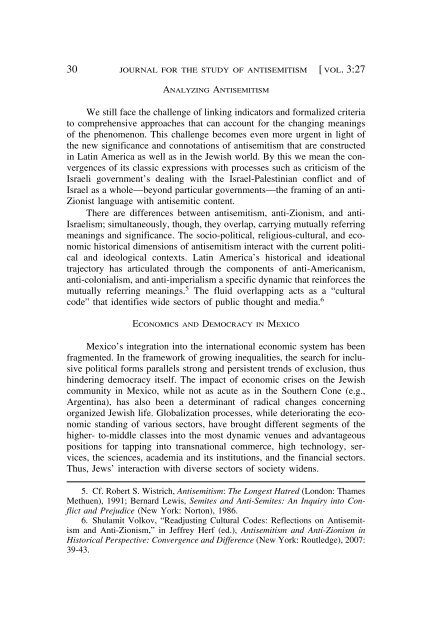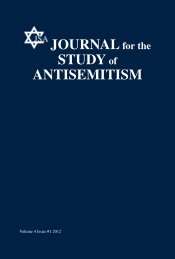JOURNALfor the STUDYof ANTISEMITISM
JOURNALfor the STUDYof ANTISEMITISM
JOURNALfor the STUDYof ANTISEMITISM
You also want an ePaper? Increase the reach of your titles
YUMPU automatically turns print PDFs into web optimized ePapers that Google loves.
30 JOURNAL FOR THE STUDY OF <strong>ANTISEMITISM</strong> [ VOL. 3:27<br />
ANALYZING <strong>ANTISEMITISM</strong><br />
We still face <strong>the</strong> challenge of linking indicators and formalized criteria<br />
to comprehensive approaches that can account for <strong>the</strong> changing meanings<br />
of <strong>the</strong> phenomenon. This challenge becomes even more urgent in light of<br />
<strong>the</strong> new significance and connotations of antisemitism that are constructed<br />
in Latin America as well as in <strong>the</strong> Jewish world. By this we mean <strong>the</strong> convergences<br />
of its classic expressions with processes such as criticism of <strong>the</strong><br />
Israeli government’s dealing with <strong>the</strong> Israel-Palestinian conflict and of<br />
Israel as a whole—beyond particular governments—<strong>the</strong> framing of an anti-<br />
Zionist language with antisemitic content.<br />
There are differences between antisemitism, anti-Zionism, and anti-<br />
Israelism; simultaneously, though, <strong>the</strong>y overlap, carrying mutually referring<br />
meanings and significance. The socio-political, religious-cultural, and economic<br />
historical dimensions of antisemitism interact with <strong>the</strong> current political<br />
and ideological contexts. Latin America’s historical and ideational<br />
trajectory has articulated through <strong>the</strong> components of anti-Americanism,<br />
anti-colonialism, and anti-imperialism a specific dynamic that reinforces <strong>the</strong><br />
mutually referring meanings. 5 The fluid overlapping acts as a “cultural<br />
code” that identifies wide sectors of public thought and media. 6<br />
ECONOMICS AND DEMOCRACY IN MEXICO<br />
Mexico’s integration into <strong>the</strong> international economic system has been<br />
fragmented. In <strong>the</strong> framework of growing inequalities, <strong>the</strong> search for inclusive<br />
political forms parallels strong and persistent trends of exclusion, thus<br />
hindering democracy itself. The impact of economic crises on <strong>the</strong> Jewish<br />
community in Mexico, while not as acute as in <strong>the</strong> Sou<strong>the</strong>rn Cone (e.g.,<br />
Argentina), has also been a determinant of radical changes concerning<br />
organized Jewish life. Globalization processes, while deteriorating <strong>the</strong> economic<br />
standing of various sectors, have brought different segments of <strong>the</strong><br />
higher- to-middle classes into <strong>the</strong> most dynamic venues and advantageous<br />
positions for tapping into transnational commerce, high technology, services,<br />
<strong>the</strong> sciences, academia and its institutions, and <strong>the</strong> financial sectors.<br />
Thus, Jews’ interaction with diverse sectors of society widens.<br />
5. Cf. Robert S. Wistrich, Antisemitism: The Longest Hatred (London: Thames<br />
Methuen), 1991; Bernard Lewis, Semites and Anti-Semites: An Inquiry into Conflict<br />
and Prejudice (New York: Norton), 1986.<br />
6. Shulamit Volkov, “Readjusting Cultural Codes: Reflections on Antisemitism<br />
and Anti-Zionism,” in Jeffrey Herf (ed.), Antisemitism and Anti-Zionism in<br />
Historical Perspective: Convergence and Difference (New York: Routledge), 2007:<br />
39-43.














